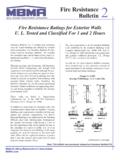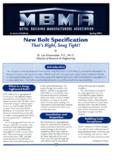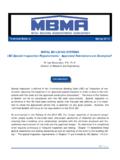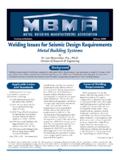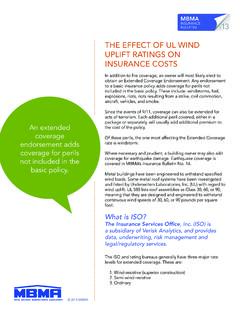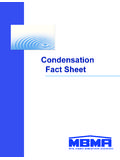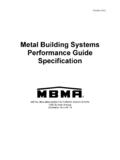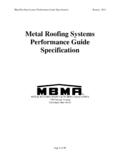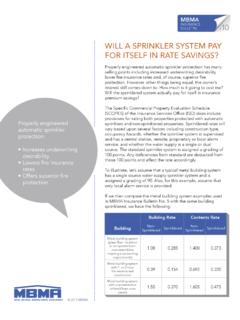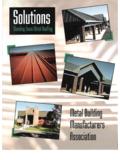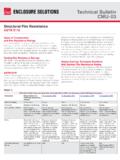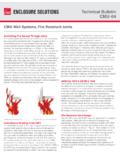Transcription of HOW METAL BUILDING INSURANCE COSTS …
1 MBMA INSURANCE look at the basic INSURANCE COSTS of METAL buildings compared to other types of BUILDING construction. 2015 MBMAHOW METAL BUILDING INSURANCE COSTS COMPARE TO OTHER BUILDING TYPESC ontractors who build with other products will compete with METAL buildings based on an assumption that INSURANCE COSTS are lower for their form of construction. While this can be true, it can also be false. Understanding the information in the various MBMA INSURANCE Bulletins, as well as the information in the MBMA INSURANCE Facts document, will help you clarify INSURANCE cost , as well as overcome this potential issue in the eyes of the this bulletin we will take a look at the basic INSURANCE COSTS of METAL buildings compared to other types of BUILDING construction.
2 In the example that follows, we will look at a typical BUILDING that is 12,500 square feet and houses a pump distribution warehouse and offices. The BUILDING is described in detail in the attached Property Narrative report that would typically be developed by an INSURANCE loss control specialist to assist the underwriter in determining an INSURANCE occupancy can impact INSURANCE pricing (as described in MBMA s INSURANCE Bulletin No. 7), we will keep occupancy (pump distribution warehouse) the same for all stated in INSURANCE Facts, construction type is a primary driver of INSURANCE rates for buildings. The INSURANCE Services Office (ISO) is the organization supported by the INSURANCE industry that compiles data used in developing INSURANCE rates.
3 For rating purposes, ISO categorizes buildings into six classes:FRAME (Construction Class 1)These are buildings with exterior walls, floors, and roof of combustible construction, or buildings with exterior walls of noncombustible or slow-burning construction with combustible floors and roof. Also included are buildings with walls and roofs with composite assemblies which include both combustible and noncombustible MASONRY (Construction Class 2)These are buildings with exterior walls of fire -resistive construction rated at not less than 1 hour, or of masonry with combustible floors and roof. NONCOMBUSTIBLE (Construction Class 3)These are buildings with exterior walls, floors, and roof of noncombustible or slow-burning materials supported by noncombustible or slow-burning supports.
4 METAL buildings normally fall into this NONCOMBUSTIBLE (Construction Class 4)These are buildings with exterior walls of fire -resistive construction rated at not less than 1 hour or masonry (not less than 4 thick) and with noncombustible or slow-burning floors and roof. MODIFIED fire -RESISTIVE (Construction Class 5)These are buildings with exterior walls, floors, and a roof constructed of materials described in Construction Class 6 fire -resistive, but have a deficiency in thickness and a fire resistance rating of less than 2 hours, but not less than 1 (Construction Class 6)These are buildings with solid (not less than 4 thick) or hollow (not less than 8 thick) masonry walls or assemblies with a fire resistance rating of not less than 2 hours and floor and roof assemblies with fire resistance rating of not less than 2 hours.
5 Horizontal and vertical load bearing protected METAL supports, with fire resistance rating of not less than 2 hours, including pre-stressed or post-tensioned concrete this example, our BUILDING is less than 15,000 square feet so INSURANCE pricing is typically based on BUILDING class rates developed by the ISO as described in INSURANCE Bulletin No. 4. Buildings larger than 15,000 square feet are generally rated individually by INSURANCE companies, applying credits and charges based on BUILDING and occupancy COSTS are the calculated loss per $100 of insured BUILDING value and are generated by ISO from their database of premiums and losses. ISO calculates these by state and within regions of each state using the historic losses reported to them by all INSURANCE companies.
6 Most states have adopted ISO Loss cost calculations as a basis for fire INSURANCE rates in the are aggregated on a state-by-state basis by ISO and are also aggregated by specific areas within a state when environmental factors such as high winds or earthquakes are prevalent. ISO also aggregates losses by BUILDING type. These historic losses are then published for states and insurers to use in the development of their specific rates. As a result, all states 2015 INSURANCE pricing is typically based on BUILDING class rates developed by the ISO as described in INSURANCE Bulletin No. INSURANCE carriers using ISO Loss cost data start with the same basic INSURANCE carriers use the ISO-developed Loss COSTS to calculate the rates they charge.
7 Each carrier multiplies the ISO-developed Loss cost rate by their own loss conversion factor or LCF. LCF s are filed by each INSURANCE carrier in each state. States vary in procedure, but they either affirmatively approve the carrier s LCF or accept it as filed. The LCF includes the INSURANCE carrier s cost of doing business and also anticipates a margin of profit. In general, these LCF s range between and What you need to remember is that, while the underlying ISO rate is uniform across INSURANCE carriers, the unique LCF for each carrier can result in a range of prices. When comparing INSURANCE COSTS between METAL buildings and other competitive types of BUILDING construction, it is important to make sure the premium pricing used is from the same INSURANCE last variable in the cost of INSURANCE is the actual value of the BUILDING .
8 All ISO rates and the LCF s used to develop pricing result in a dollar rate for each $100 of BUILDING s take a look at how these variables impact the cost of INSURANCE on our model a study completed in 2010, we looked at insuring our model BUILDING in four different states. We also looked at INSURANCE COSTS if the model BUILDING were constructed in each of the six ISO BUILDING classes. In addition, we compared the INSURANCE cost for each BUILDING type constructed in four different states with differing environmental noted in the attached report, the four cities where the model BUILDING was priced were: Bryan, TX 77803 Delray Beach, FL 34444 DuBois, PA 15801 La Mesa, CA 91945 We assumed that, in each state, our hypothetical INSURANCE carrier had filed a loss conversion factor of 2015 MBMAThe ISO rates for these locations are listed in the table below.
9 They were provided by INSURANCE carrier representatives contacted for this study and were modified by the loss conversion factor stated the other important variable in determining total INSURANCE cost is the value of the BUILDING to be insured, we researched typical BUILDING COSTS using historic, published RS Means data for each of the six BUILDING types in the four locations. The following table shows the BUILDING COSTS produced by this gross INSURANCE COSTS for each location can be then calculated by multiplying the INSURANCE rate by the BUILDING cost divided by 100. The chart below shows the theoretical annual cost for INSURANCE for each BUILDING . This cost is for fire and multi-peril ( fire , windstorm, earthquake) INSURANCE on the BUILDING only and does not include INSURANCE on the contents in the BUILDING .
10 So what does the data show?The above table shows that the cost to insure our model BUILDING is less than either frame or joisted masonry in all four states. It also shows that METAL buildings cost less to insure than any class of BUILDING in California. If INSURANCE cost is the only LocationFrameJoisted MasonryMetal BUILDING System 1 METAL BUILDING System 2 MasonryNoncombustibleModified fire - ResistiveFire- ResistiveBryan, TX$ $ $ $ $ $ $ Beach, FL$ $ $ $ $ $ $ , PA$ $ $ $ $ $ $ Mesa, CA$ $ $ $ $ $ $ MasonryMetal BUILDING System 1 METAL BUILDING System 2 MasonryNoncombustibleModified fire - ResistiveFire- ResistiveBryan, TX$692,000$713,000$756,524$756,524$720,5 00$764,000$993,200 Delray Beach, FL$765,500$783,000$834,741$834,741$800,0 00$837,500$1,088,750 DuBois, PA$860,500$875,000$972,625$972,625$893,5 00$937,500$1,218,750La Mesa, CA$970,500$952,000$1,016,900$1,016,900$9 35,000$1,016,600$1,321.
